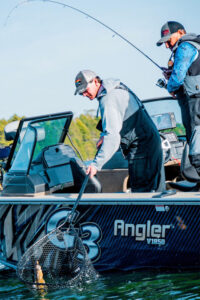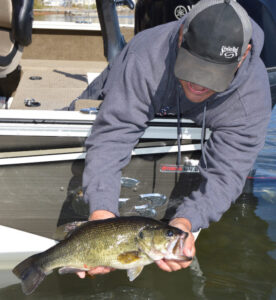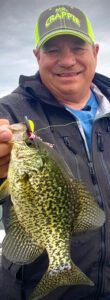Make A Cast, Catch A Fish
By Mike Frisch
The sport of fishing, including the lures we use and the way we present them, are constantly changing. Two of my personal favorite ways to catch fish over the years involved vertical presentations, one for walleyes and the other for bass. Recently, however, I have made adjustments to those presentations and seem to be catching more fish as a result of those adaptations. Here is a look at those changes.
Many walleyes have been caught over the years by “vertical jigging,” that is dropping a jig, usually baited with a minnow or leech, over the side of the boat and using the rod to incorporate various movements designed to attract walleyes and then trigger them into biting. This method often resulted in good catches for me and other anglers when walleyes were located in the mid-depths or deeper waters, say anytime the water was 15 feet or deeper.
In recent years, however, waters in lots of lakes across the Midwest are much clearer than in the past. Clear water and walleyes often means fish that are much more wary regarding the boat’s presence. For that reason, I find myself opting to make long casts with my jig/bait combinations and then working those baits slowly back to the boat. Those long casts allow the baits to reach fish out away from the boat without “sitting on,” and potentially spooking, those walleyes.
Long casts prevent spooking fish, but I also find myself liking a casting presentation because I can fish all around my boat searching for pods of fish. Recently, for example, a partner and I were on Kabetogama Lake in northern Minnesota fishing mid-depth humps where we anchored our boat on the humps and then casted around the boat to effectively fish them. This method resulted in a bunch of eater walleyes coming to the boat and several over 20 inches being caught and released as well.
Long casts are producing good walleye catches, but they are effective for bass too. A Texas rigged plastic bait, often a Rage Craw or a Rage Menace, has been a go to lure for me for several years now when targeting bass in weeds on flats during summer and fall. In the past, I would often make short pitches to suspected bass-holding cover and then let the bait settle in before hopping it a couple times and reeling up and making another pitch.
Again, because the water is clearer in most lakes now, I find myself holding further away from likely spots and the bass on them and making a bit longer cast to avoid alerting the fish to my presence. While I don’t think bass in deeper weeds on flats necessarily spook from the boat, I do think they know the boat is there. And, because bass fishing pressure has increased significantly on many lakes, the fish have seen more boats and more lures making them less apt to bite when they sense a boat near than maybe they were even just a few years ago.
Things in the fishing world are certainly different than they were even in the not-too-distant past. Whether you prefer fishing bass or walleyes, the environments those fish live in are changing and the successful angler is usually the one who adapts best to those changes. Making longer casts is one adjustment this angler has made and one that seems to have led to better catches in my boat.
As always, remember to include a youngster in your next outdoors adventure! Photo – The author and a fishing partner land a Kabetogama Lake walleye caught on a jig and minnow fished on a long cast.
Mike Frisch hosts the popular Fishing the Midwest TV series and is a co-founder of the ZEBCO School of Fish. Visit www.fishingthemidwest.com to see all things Fishing the Midwest.





